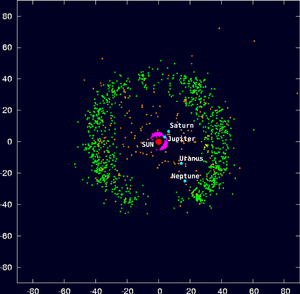Part I
Directly, the answer to your question was from a pervious post, found in the following sentence, however I’ll admit it was rather laconic and vague.
‘Remember everything within the graphic is in motion and this is relative, not scattered nor random.’
As a reference, this may sound a bit obtuse, but please bear with me, as this provides the rationale for my answer. Previously I posted that the way the Copernican Principle has recently been employed, i.e. the earth is as good as any other place to observe the universe, is utter rubbish. I maintain that the earth is actually a horrific place (but not the worst) to view the universe, as there are available far better points from which to surveil.
The reasons are as follow. First, in theory our planet lays within the Terran star system, wherein we have a single G2 class base star, several planets; several dwarf planets, numerous moons, billions of smaller bodies, debris, dust, solar winds, the Interplanetary Medium, and the Oort Cloud. All of these exist within a horizontal plane, which is tilted at a particular angle in relation to our galaxy, and is in relative motion around the base star, our sun. Although collectively, these motions are not uniform, yet neither are they random, as there is an interdependence, however dominated by the base star.
Next our Terran star system is in motion within a Local Interstellar Cloud, known as the Local Fluff. This is an outflow from the Sco-Cen, and is roughly 30 light years across. This gas cloud has a temperature of 6000° C, which is about the same surface temperature of the Sun. Overall, it’s very dispersed, with a density of 0.26 atoms per cm3. Interestingly the Local Fluff is in motion in relation to the Sco-Cen. Again this motion is not random.
Our system along with the Local Fluff and other fellow travelers are in motion within the Local Bubble. This is a cavity in the interstellar medium, which I’ll get to next. It’s about 300 light years from one side to another and has a neutral hydrogen density of approximately 0.05 atoms per cm3. This diffused gas is hot and somehow emits X-rays. This in part is likely due to the Local Bubble being the remains of a supernovae that exploded between two to four million years ago.
Next our system, the Local Fluff, and the Local Bubble are in motion within the interstellar medium which is in turn associated with the Orion Arm. The interstellar medium (ISM) is another gaseous formation that surrounds the stars that compose the greater structure of our Milky Way Galaxy. Its density is about 0.5 atoms per cm3. Overall the ISM within the Orion Arm (OA) is very big and as one of several minor arms, the OA is in motion between the Sagittarius and the Perseus arms, two of the four major arms of the our galaxy. All these are in relative motion, which is dominated by the center of our galaxy. Although so complex they're beyond our current understanding, none of these motions can be classified as random.
Beyond this, along the plane of the intergalactic horizon is intergalactic space which, as provided above, has a theoretical average density of around one hydrogen atom per 1 m3. This expanse is in motion as is the Local Group, seen in the graphic above, as are the seemingly numberless other groups of galaxies found further afield. Again, all these are in motion and these motions are all relative.
The point and the answer to question to follow.
CmacQ








 Reply With Quote
Reply With Quote
Bookmarks